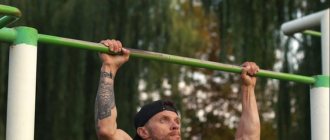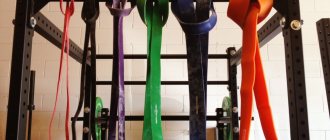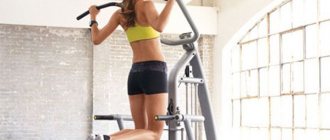A simple but effective pull-up scheme will help beginners build up their arm muscles from scratch. This exercise is basic in many training programs designed for muscle growth. The secret of the scheme is to gradually increase the load, which allows you to avoid injury and achieve amazing results. But to achieve effectiveness, you must strictly follow the rules and listen to the recommendations of professionals.
History of origin
Not everyone knows that the history of pull-ups on the horizontal bar began in Ancient Greece. Even then they were included in the basic exercise system. This means that people have long been aware of the high effectiveness of pull-ups. With the help of this exercise, it is possible not only to build muscle mass, but also to form a harmonious relief.
On a note! Among the monks of Tibet, the technique of pull-ups on the horizontal bar has been improved by including a number of unique elements in the standard training complex. This allows you to get even more efficiency from your classes and achieve amazing results.
What muscles work?
When performing pull-ups on a horizontal bar or crossbar, the following muscle groups are actively worked out:
- biceps;
- back muscles;
- chest muscles;
- muscles of the forearm;
- press.
We can say with complete confidence that the horizontal bar is a universal apparatus that helps to work out the main muscle groups.
Basic Rules
To achieve effectiveness when pulling up on the horizontal bar, you will need to follow the following rules:
- the back must be kept straight;
- when lifting the body at the highest point, you should touch the bar with your chin;
- to build muscle mass, you need to rise slowly and lower your body quickly;
- Fast ascent and slow descent will help strengthen your muscles;
- to stretch the muscles and give them flexibility, you should quickly raise and lower the body, and between approaches fix the body position in a sagging position for several seconds;
- sudden movements are unacceptable, they must be smooth, which will help avoid injury;
- Before each workout, you need to do a warm-up, setting aside literally 5 minutes for it - jogging in place, jumping rope, cycling and other simple exercises are suitable as a warm-up;
- if you want to build muscle mass by doing pull-ups on the bar, you will have to radically change your diet by introducing foods high in protein, and also slightly increase your daily caloric intake;
- After each workout, it is important to do a little stretching, thanks to which the muscles will be able to recover faster and gain weight.
By following these simple rules, you can quickly achieve the desired result when doing pull-ups on the horizontal bar.
Contraindications to pull-ups
Very often there is a confusion between the concepts of exercise on the bar and pull-ups. Therefore, contraindications are not always correctly determined.
For some diseases, pull-ups on the bar are strictly contraindicated:
- intervertebral hernia;
- disc protrusion;
- scoliosis in development stage above II;
- all diseases occurring in acute form;
- hand injuries;
- atherosclerosis;
- varicose veins.
If you have other diseases, exercise should be treated with caution.
Types of pull-ups
There are two main types of pull-ups on the horizontal bar, each of which differs in a specific technique. The main difference is the placement of the hands.
The first type of pull-ups is with a direct grip (palms turned away from the body). In turn, it happens:
- narrow – hands are shoulder-width apart;
- medium - the hands are located at a distance of about 10 cm wider than the shoulders;
- wide – the hands are placed at the greatest possible distance from each other.
The second type of pull-ups is with a reverse grip (the hands are turned towards the body). Similar to the previous option, the reverse grip can be narrow, wide and medium.
Popular techniques. Lewis Armstrong pull-up system.
The plan for pull-ups on the horizontal bar, proposed by US Army Major L. Armstrong, is aimed at achieving a mandatory result of 20 pull-ups in 2 months. Training schedule – 5 times a week. The peculiarity of the method is that the emphasis is shifted towards perfect execution of the exercise, from a technical point of view, to the detriment of the number of repetitions.
- Day 1: 5 sets with as many repetitions as possible. Breaks are 1.5 minutes. Practice shows that in the last two approaches the results improve.
- Day 2: “pyramid” with step 1.
- Day 3: choose the optimal possible number of repetitions per set in order to complete 9 sets with exactly the same number of pull-ups in each of them. Every 3 sets you need to change your grip. Rest between sets 1 minute.
- Day 4: Complete as many sets as possible. If you manage to do more than 9, then next week you need to add 1 repetition per set.
- Day 5: select and repeat the hardest day in the weekly cycle.
Execution technique
The correct technique for performing pull-ups on the horizontal bar:
- Hang freely on the horizontal bar, grasping the bar with a certain type of grip. Legs slightly bent at the knees, feet crossed.
- Exhale and lift your body, placing your chin over the bar. The body is strictly vertical and does not deviate to the sides.
- Slowly lower while inhaling.
On a note! Correct breathing technique is important when performing any exercise, including pull-ups on the horizontal bar.
Grips and hand positions[edit | edit code]
The Phase I and Phase II programs use the standard overhand pull-up technique (same as in the initial test), the reverse grip pull-up technique, and the following variations. As you remember, a direct grip is called an overhand grip (palms facing forward), and a reverse grip is an underhand grip (palms facing you). Small changes in both grip variations allow you to emphasize different muscle groups and help balance the load.
NEUTRAL GRIP
. Neutral grip pull-ups are the easiest for many people. With this technique, the arms are slightly pulled into the shoulders, which allows you to use most of the muscles of the middle and upper body (biceps, deltoids and pectoral muscles) in the final phase of the movement. Neutral-grip pull-ups are sometimes referred to as full-body pull-ups because you can use so many different muscle groups. Neutral-grip pull-ups can only be performed on a bar with handles positioned at a 90-degree angle to the main bar. If you don't have such tools, perform close-grip pull-ups instead.
NARROW GRIP
. A close grip can be either forward or reverse, and if you don't have a bar with perpendicular handles, these pull-ups will serve as an equivalent substitute for neutral grip pull-ups. Among other things, this grip can be used if you experience any pain or excessive fatigue from doing pull-ups with a standard or wide grip. Close-grip pull-ups make pull-ups much easier for those with strong biceps and provide a good workout for the arms, chest, and shoulder girdle. They also allow you to use almost every muscle in your mid and upper body, making them a great way to build full-body strength.
Grab the bar with an overhand or reverse grip. The distance between your hands should be between 5 and 15 cm. Since your elbows are now further away from your torso than with a standard grip, focus on pointing them towards your lower abdomen, towards your navel line. When performing the exercise with an overhand grip, you will have to lean back slightly so as not to touch your hands with your face.
WIDE GRIP
. Pull-ups with this grip are generally considered the most difficult, and can cause excessive tension in the shoulder girdle for some people. Such pull-ups are contraindicated if there is injury or pain in this area. Wide-grip pull-ups are a great way to isolate the trapezius and latissimus dorsi muscles, as well as sculpt the deltoids, but don't try to do a lot of them until those muscles are strong enough to handle the extra strain of such isolation. This is why the number of wide-grip pull-ups in Phase I is strictly limited. If you feel too much tension or pain in your rotator cuff muscles, immediately switch to a standard, neutral, or close grip.
Ways to safely do pull-ups on a horizontal bar for a beginner
If the muscles in your arms are not sufficiently developed, it is sometimes difficult to do even one pull-up, let alone complete a training program according to a specific schedule. Professionals recommend that beginners use the following methods to learn how to do this exercise:
- using a stool - if you stand on a support, it will be easier to pull yourself up, raising your body to the maximum point, you need to stay in this position for 3 seconds and then jump down (gradually, the time of fixing the body should be increased);
- belay with an elastic band - the athlete ties himself around his waist with a sports rubber band and hangs it from the crossbar, thanks to this trick it will be easier to pull the body up;
- jerk pull-ups - at first it will be easier to do the exercise this way, but it also becomes more traumatic, so it is only suitable for a few workouts.
As a rule, if all recommendations are followed, beginners master the technique of performing pull-ups within 30 days.
Training programs for different levels of training: table of classes for 30 days.
The table for pull-ups on the horizontal bar is compiled based on the rules and recommendations for training on gymnastic equipment. Fundamentally, each table is compiled for each contingent of students and for each age group.
Zero level
When starting training, you should not rush and try to achieve success right away. You need to go to it gradually, observing all the subtleties of the correct technique. At the very beginning and forever, you need to remember that working on a high bar poses a potential danger. Therefore, all actions, especially at the initial stage, are carried out with insurance.
| Exercise name | Athlete's actions | Insurance | Sets/reps |
| Leap onto the projectile, dismount. | From a half-squat position (arms outstretched down and back), jump up, bending over, and hang on the crossbar. Lock in. Raising your straight legs slightly, swing forward. On the 3rd swing, do a bending dismount. Land in a half-squat, feet shoulder-width apart, straight arms slightly apart to the sides, extended forward and upward. | 1 person is insured. Both stand to the side, facing the athlete. One - with outstretched arms from the stomach and back in readiness to catch when falling. The second, without interfering with the jumper, lightly places one palm on the lumbosacral region, and the second on the solar plexus area. When jumping, it corrects the position of the body. During dismount No. 1, he holds his hands in the area of the shoulder blades and navel. No. 1 continues to underwrite. | 3/10 |
| This exercise must be mastered first. It guarantees the correct attack on the projectile without outside help and a safe dismount. Feature of execution: in the starting position, do not lift your head and do not look at the crossbar. You need to see her already in the jump. Make the deflection as if the body should slide under the crossbar. When dismounting, the deflection is in the form of an arc along which the body slides, repeating the trajectory of the heels. | |||
| Hanging on two hands with a classic grip. | After the pounce, fix the hang. The correct position of the hands is shoulder width apart. Do not strain your arms (especially your hands) too much, otherwise they will quickly get tired. Perform 5 twists of the body in each direction. Perform the dismount while bending over. | There are two belayers. The actions are described in the previous paragraph. | 3/10 |
| Pull-ups with the help of assistants. | Pull yourself up from a hanging position with the help of assistants. Legs straight, toes pointed. The movement proceeds without swaying with a slight deflection. At the end of the move, add movement by lifting the wrists. Do not lift your head up and do not place your chin on the bar (the bar should be below the level of the chin when the head is held straight). Fix the position. Slowly, in a small arc (the deviation of the heels from the projection of the crossbar is no more than 10 cm), lower yourself to a hanging position. | The insurers are in the same position. The hands of the first are on the waist, the hands of the second are hugging the middle part of the thighs. When lifting, both smoothly help the performer to pull himself up. At the top point, release your hands and belay yourself when lowering. | 3/5 |
| Pull-ups without assistance | Do not strive to complete the movement to the end. Perform smoothly, slowly and without jerking. It must be remembered that this is a preparatory exercise for practicing the technique of performing the technique. | There is only one belayer. Pay special attention to the dismount. | If possible |
Read more: Supersets for the back and pectoral muscles
The training table, built taking into account this program, allows any beginner to independently perform several pull-ups on the horizontal bar after a week. With proper technical execution, this is already a good result.
You need to strive to perform the exercise correctly, when the body is elongated, the legs are straight and compressed, and the toes are pointed, for a simple reason: the girl needs proportional development, and not a pumped-up shoulder girdle and back.
With bent legs, incorrect grip and technically incorrect execution, the exercise turns into a technique for pumping individual muscles. And vice versa - when performed correctly, it serves as a tool for proportional training of almost all muscle groups.
No matter how ridiculous it may sound, some people cannot do a single pull-up. And it's not that they are heavy. It's not that pull-ups are difficult exercises. It’s just that people have never practiced this; their muscles “don’t know” how to contract correctly. This is especially true for representatives of the fair sex.
It is advisable for a man to perform pull-ups at least 10 times at a slow pace without jerking.
Getting used to hanging
Any program must include elements of preparation. First you need to find a good crossbar. It must be at an accessible height. That is, so that you can reach the horizontal bar from a small jump or by rising on your toes.
So, grab the horizontal bar with an overhand grip, placing your hands slightly wider than shoulder-width apart. Hang from the horizontal bar without your feet touching the floor or ground. The first time you can hang for up to 5 seconds, then your hands will unclench. And the more you weigh, the funnier you will slide off the horizontal bar - this is normal. To fully do at least 10 pull-ups, you need to hang on the horizontal bar for at least 40 seconds. This is necessary for beginners who may slip off the bar at the most inconvenient moment.
To increase your hang time simply add 1-2 seconds each time until you reach 60 seconds. Your hands will shake - be patient. All physical achievements come through overcoming oneself.
However, try not to overwork yourself. If you can hang for 1-2 seconds, that's okay. Practice. Hang 3-5 times every day. In a month, you will see that the time you hang on the horizontal bar has noticeably increased. The main thing for beginners is the goal. You need to develop the habit of achieving it.
Beginners don’t get their first pull-up right away. It seems to have strength, it seems to be not heavy, but it never works out. The muscles “don’t know” what to do and how to contract. This is similar to the ability to tense the desired muscle in isolation. If you explain how to do this, everything will work out pretty quickly. If you cannot pull yourself up due to muscle atrophy, everything is more complicated. But you can always learn.
The first pull-up can be achieved in several ways.
Pull-ups are a good exercise for the core muscles. Depending on the grip, different muscles work. Achieving results 50 or 100 times is realistic. In this case, it is a pull-up with a neutral or parallel grip.
Thanks to the training method on the horizontal bar, based on the book by author B. Stewart called “50 pull-ups in 7 weeks.” It gives a good effect. It should be noted that for beautiful forms, 20 pull-ups with weights are enough, but for those who strive to achieve good results in terms of the number of times, you need to follow the methodology.
The 50 pull-up program is aimed at gradually increasing the number of pull-ups with different types of grips. Let's look at the execution technique.
Readers found these materials useful:
Ways to improve results
There are several tricks that will help improve the results of pull-ups on the horizontal bar:
- ensure a secure grip - wash your hands with soap, apply magnesium to your palms (you can use regular chalk), degrease the surface of the crossbar;
- using an ergonomic grip - turn your palms towards you, the distance between the hands is from 10 to 20 cm;
- compliance with the correct breathing technique (when lifting, exhale, and when lowering the body, inhale).
These are the main secrets that will help you do pull-ups on the horizontal bar easier and more effective.
Training program table
Pull-up charts provide a 30-week training schedule for beginners.
First 10 weeks
| A week | 1 | 2 | 3 | 4 | 5 | 6 | 7 | 8 | 9 | 10 |
| Approach 1 | 6 | 7 | 8 | 8 | 9 | 10 | 10 | 11 | 12 | 12 |
| Approach 2 | 5 | 6 | 6 | 7 | 7 | 7 | 8 | 8 | 8 | 9 |
| Approach 3 | 5 | 5 | 5 | 5 | 6 | 6 | 6 | 7 | 7 | 7 |
| Approach 4 | 4 | 4 | 5 | 5 | 5 | 6 | 6 | 6 | 7 | 7 |
| Approach 5 | 3 | 4 | 4 | 5 | 5 | 5 | 6 | 6 | 6 | 7 |
| Total | 23 | 26 | 28 | 30 | 32 | 34 | 36 | 38 | 40 | 42 |
10−20 week
| A week | 11 | 12 | 13 | 14 | 15 | 16 | 17 | 18 | 19 | 20 |
| Approach 1 | 13 | 14 | 14 | 15 | 16 | 16 | 17 | 18 | 18 | 19 |
| Approach 2 | 9 | 9 | 10 | 10 | 10 | 11 | 11 | 11 | 12 | 12 |
| Approach 3 | 8 | 8 | 8 | 9 | 9 | 9 | 10 | 10 | 10 | 11 |
| Approach 4 | 7 | 8 | 8 | 8 | 9 | 9 | 9 | 10 | 10 | 10 |
| Approach 5 | 7 | 7 | 8 | 8 | 8 | 9 | 9 | 9 | 10 | 10 |
| Total | 44 | 46 | 48 | 50 | 52 | 56 | 56 | 58 | 60 | 62 |
20−30 week
| A week | 21 | 22 | 23 | 24 | 25 | 26 | 27 | 28 | 29 | 30 |
| Approach 1 | 20 | 20 | 21 | 22 | 22 | 23 | 24 | 24 | 25 | 26 |
| Approach 2 | 12 | 13 | 13 | 13 | 14 | 14 | 14 | 15 | 15 | 15 |
| Approach 3 | 11 | 11 | 12 | 12 | 12 | 13 | 13 | 13 | 14 | 14 |
| Approach 4 | 11 | 11 | 11 | 12 | 12 | 12 | 13 | 13 | 13 | 14 |
| Approach 5 | 10 | 11 | 11 | 11 | 12 | 12 | 12 | 13 | 13 | 13 |
| Total | 64 | 66 | 68 | 70 | 72 | 74 | 76 | 78 | 80 | 82 |
On a note! Doing pull-ups is required from 4 to 6 times a week, which depends on the physical fitness of the athlete. Between approaches you need to do intervals of 2 minutes.
To effectively perform pull-ups on the horizontal bar, you need a training program, the diagram of which is presented in the tables. According to their data, the number of repetitions gradually increases over 30 weeks, which allows you to slowly increase the load on the muscles.
Let's consider options for schemes for all stages of preparation.
Entry level of training
For beginners who do 0-1 pull-ups, you need to start doing pull-ups with assistants, or with the help of special bands and simulators (gravitron). A little help pushing the weight is necessary for maximum muscle contraction. By working with a counterweight you can quickly adapt to your own weight. It is necessary to perform four approaches, first the maximum number of times, then increase the number of pull-ups (by 1 rep) every week. Train in this way until you can easily do 10-12 pull-ups. Next you need to move to the next level.
Advanced level of training
If pull-ups are easy, more than 12 reps with your own weight.
The horizontal bar training program for athletes who can do more than 12 pull-ups with ease involves working with additional weights. In this case, you will need special belts for pull-ups with a chain on which you can hang pancakes and weights of the required weight. You need to start with a minimal weight, first add 5 kg, after adapting to the weight and performing 10-12 pull-ups, add weight. And so on, increasing the load, but not exceeding 12 pull-ups.
Benefits of a pull-up program
The main advantages of this pull-up program include:
- increasing the volume of load - in this case we are talking about the total number of repetitions in one approach;
- a reasonable number of approaches - according to the plan, each workout includes 5 approaches, which allows you to achieve the effectiveness of the exercise and at the same time prevent overstrain in the muscles;
- real time frame for achieving the goal - the training program is designed for 30 weeks, this is quite enough to achieve the required result without much effort;
- Between workouts, rest periods are provided - in accordance with the scheme presented in the tables, it is not necessary to exercise every day, 4 times a week is enough.
In other words, the exercise system, developed for 30 days, allows you to strengthen the muscles of the arms, back and chest, as well as build muscle mass, without significant effort.
Bar training schemes for achieving high performance
The methods of this group of programs are characterized by a high degree of load and intensity. You can try some of them only with good general physical preparation. More used as additions to the main tasks of the training cycle.
1. “Maximum effort”
The basis of the program is 5 approaches with a maximum number of repetitions and short rest intervals (up to 3 minutes).
In the 1st set, you must do at least 80% of the repetitions of your maximum personal result. In each subsequent set, 5% is added so that in the last, 5th set, you work until “muscle failure”.
2. “100 pull-ups for time”
The number 100 is “floating”. No hundreds - no program, no sentence in this method. You need to focus on your capabilities, and the point of the scheme is to limit the time for performing pull-ups, without strict requirements for the number of approaches. For example, you can do 9 approaches, starting with 15 repetitions, and reduce the number in each subsequent approach, ultimately getting 100. The main thing is to do everything in the shortest possible period of time.
3. “Repeated loads”
This method is effective for developing muscle strength endurance. To give them the impulse of “strength work,” the exercise is performed at a low pace with short pauses for rest. The grip technique changes with each new approach.
Pull-up pattern
- 1st set – pull up 3 times less than your best result;
- do 2-3 pull-ups, a short rest (up to 30 seconds) and a new similar approach;
- continue training in the given mode until the technique begins to “limp”.
4. "Pyramid"
The size of the “step” and the top of the “pyramid” are selected individually (and, accordingly, the total number of repetitions).
“Step” - increasing or decreasing the number of repetitions in the “pyramid line” by 1,2 or 3 times.
The top of the “pyramid” is the point where the maximum specified number of increasing repetitions is reached, after which the load decreases.
Example of constructing a load (step=2): 1-2-4-6-8-6-4-2-1 =34
Recovery periods are not strictly regulated - according to personal feelings.
"Personal record"
This is a pull-up increasing system aimed at achieving your best personal performance. A universal method, relevant for different types of strength exercises. Three sets – warm-up, preparation, record.
- The task of the 1st set is to prepare the muscles for maximum load and consolidate technical skills. 40% of the best result is completed. The recovery phase before the 2nd approach is at least 2 minutes;
- in the 2nd set, the intensity of the load increases - without much effort you need to pull yourself up to 80% of your capabilities. Rest before the decisive set - 3 minutes;
- 3rd set – full mobilization of strength and an attempt to set a personal record in pull-ups on the horizontal bar.
Disadvantages of the pull-up program
It turns out that this set of pull-ups has not only advantages, but also disadvantages. They are expressed as follows:
- the same number of repetitions - this point is an advantage for some, and a disadvantage for others, but the program is designed for beginners, and professionals who dream of breaking the barrier of 15 approaches can choose a different training system;
- if you train for 6 days, as allowed in the program, overwork may begin, both in the nervous and muscular systems;
- this program is not suitable for beginners who do not know how to do pull-ups at all; they will first have to go through the preparatory stage of training for thirty days;
- there are no exercises that force synergistic muscles to work - according to experts, loading these muscle groups makes it possible to accelerate progress in pull-ups;
- lack of balancing load - when performing one type of pull-up, one-sided development of the body is formed.
Despite the above disadvantages, the 30-week pull-up program is a success not only among beginners, but also among professional athletes.
How to use the training schedule[edit | edit code]
The program is designed for several weeks, each of which has three training days. Each activity is listed on a line for a specific day, and if we take Monday for example, we will see that you have to warm up, perform 5 overhand grip pull-ups, rest for 60 seconds, perform 4 reverse-grip pull-ups, etc., until complete all 5 sets, after which you will need to do stretching exercises.
STRAIGHT GRIP PULL-UP RECORD IN 6 HOURS (MEN): 2968 Stephen Hyland (Great Britain) June 24, 2007, Surrey, England
12 HOUR STRAIGHT GRIP PULL-UP RECORD (MEN): 3165 Jason Armstrong (USA) May 30, 2010, Pacific Grove, California
24 HOUR STRAIGHT GRIP PULL-UP RECORD (MEN): 3355 Jason Armstrong (USA) May 30-31, 2010, Pacific Grove, California (attempt completed after 15 hours 48 minutes; remaining time unused)
| Week 1 | Rest between sets - 60 s (longer if necessary) | ||||||
| Monday | Warm-up | 5 straight grip | 4 reverse grip | 5 neutral/close grip | 4 reverse grip | 3 straight grip | Stretching |
| Tuesday | Day of rest | ||||||
| Wednesday | Warm-up | 6 straight grip | 5 reverse grip | 5 neutral/close grip | 6 reverse grip | 4 straight grip | Stretching |
| Thursday | Day of rest | ||||||
| Friday | Warm-up | 5 straight grip | 6 reverse grip | 6 neutral/close grip | 5 reverse grip | 5 straight grip | Stretching |
| Saturday | Day of rest | ||||||
| Resurrection | Day of rest | ||||||











